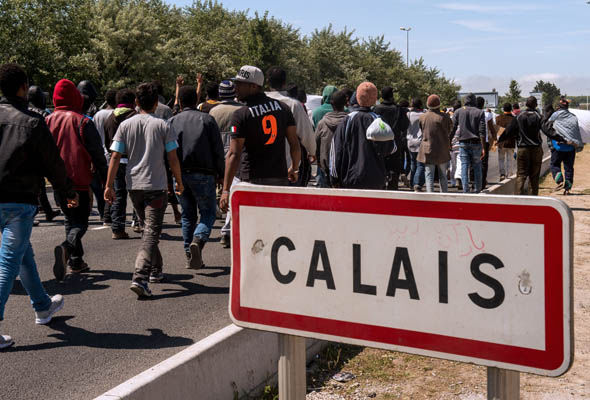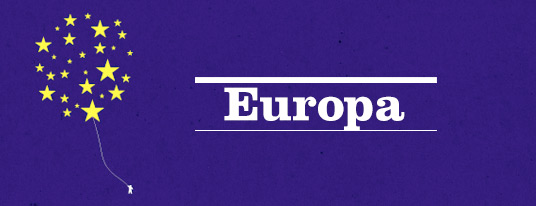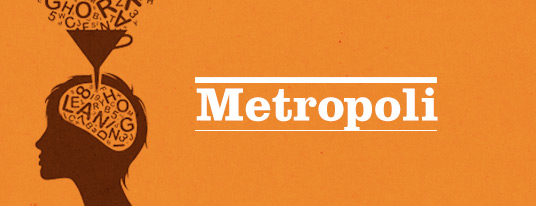by NICHOLAS DE GENOVA.*
Ever since Marx and Engels proclaimed in The Communist Manifesto that the workers have no country, it has been an elementary and defining premise of Marxist politics that we are internationalists1. There has never been a more clear proof that Stalinism involved a radical betrayal of Marxism, furthermore, than the devious and self-serving proposition that it was possible to build “socialism in one country”. Indeed, the prominence of the word “international” in the name of this journal is meant to confirm its commitment to a specifically Marxist socialist politics while also emphatically distinguishing itself from the wretched counter-revolutionary legacy of Stalinism. It is instructive to take this fundamental internationalist perspective of any genuinely Marxist politics as a starting point for any Marxian reflection on questions of migration and borders. After all, we are left to wrestle with a very meaningful and consequential paradox: the workers have no country, and yet we live in a world of supposedly separate and distinct “countries,” – a world partitioned into “national” states.
A Marxist politics of internationalism must necessarily offer a rigorous critique of nationalism, but there can be no adequate critique of nationalism without a theory of the state, particularly as “the” state everywhere refers to a multiplicity of separate and distinct states, which usually fashion themselves quite emphatically as “national.” Given the global configuration of the capitalist world economy, we must therefore be able to account for why it is that instead of a global state, we have a great proliferation of territorially-defined and delimited (nation-)states. Therefore, understanding the very process by which a state is thus territorially delimited — understanding, in other words, how a state comes to be defined by borders — should be a central problem in accounting for the relation between the territorially-defined (“national”) state and global capital. Furthermore, if the workers as a class on a global scale have no country, there is surely no better lived and embodied example of this proposition than those migrant workers who cross nation-state borders. In short, international migration is never separable from the global mobility of labour, and any meaningful socialist internationalism must begin from this fact. In this respect, theoretically speaking, there can literally be no viable socialist internationalism that does not take migrant labour as a premier subject of any radical working class politics.
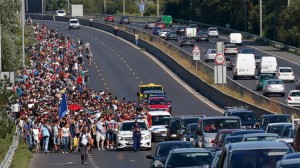 In this article, I will start by reflecting on the beleaguered figures of migration and refugee movements into and across Europe, and therefore will also examine the equivocal figure of the borders of this ambiguous and amorphous place called “Europe.” We must begin by interrogating what has variously been called the “migrant crisis” or the “refugee crisis”, which is otherwise taken to signal a “crisis” of the borders of Europe. Beyond an examination of the proliferation of discourses of “crisis,” however, I also want to trouble the very figure of “Europe”. Finally, I want to suggest the outline of a way of theorising this ostensible “crisis” of the European border regime by reflecting more generally on migration and borders. I do not intend merely to provide a descriptive historical contextualisation of the political economy or geopolitics that may pertain to better comprehending what the current situation is all about. Rather, I want to elaborate some theoretical tools for thinking about these more elementary analytical categories — migration, borders, and so forth. In order to sustain a genuinely Marxist critique, it will be necessary to refuse to take for granted the very conceptual categories that organise this dominant discourse of the putative “crisis” of the European border regime.
In this article, I will start by reflecting on the beleaguered figures of migration and refugee movements into and across Europe, and therefore will also examine the equivocal figure of the borders of this ambiguous and amorphous place called “Europe.” We must begin by interrogating what has variously been called the “migrant crisis” or the “refugee crisis”, which is otherwise taken to signal a “crisis” of the borders of Europe. Beyond an examination of the proliferation of discourses of “crisis,” however, I also want to trouble the very figure of “Europe”. Finally, I want to suggest the outline of a way of theorising this ostensible “crisis” of the European border regime by reflecting more generally on migration and borders. I do not intend merely to provide a descriptive historical contextualisation of the political economy or geopolitics that may pertain to better comprehending what the current situation is all about. Rather, I want to elaborate some theoretical tools for thinking about these more elementary analytical categories — migration, borders, and so forth. In order to sustain a genuinely Marxist critique, it will be necessary to refuse to take for granted the very conceptual categories that organise this dominant discourse of the putative “crisis” of the European border regime.
The Proliferation of “Crisis”
When a ship transporting as many as 850 migrants and refugees capsized on 19April 2015, all but 28 of the vessel’s passengers were sent to their deaths in what appears to have been the worst border- crossing shipwreck in the Mediterranean Sea on record. This single event instantly established the prospect that 2015 would earn the dubious distinction of the most deadly year to date for would-be “asylum-seekers” braving Europe’s borders. Subsequently, unnumbered capsized “migrant boats” and incidents of mass death turned that grim likelihood into a gruesome truth. These human catastrophes at sea have indisputably transformed the maritime borders of Europe into a macabre deathscape. Then, on 2 September 2015, social media as well as mass news media were briefly haunted by photographs of the corpse of a drowned Syrian child, soon identified as Aylan Kurdi, washed ashore in Turkey after a failed attempt to reach the Greek island of Kos left at least 12 people dead. Abruptly, the desensitising and rather cynical rhetoric of a “migrant crisis” began to recede in favour of appeals for compassion in the face of tragedy, accompanied by a reinvigorated (if ephemeral) language of “refugee crisis”2.
The putative “crisis” surrounding the influx of migrants and refugees in Europe — and the border spectacle that it generates3 — is nowhere more extravagantly put on display than in the Mediterranean Sea. Indeed, for several years now, the European Union (EU) has converted the Mediterranean into a mass grave. The singularity or momentousness of the 19 April shipwreck was in fact only apparent, however, because it came as merely the most ghastly and most publicised in a long and unrelenting list of comparable episodes that have utterly banalised such human disasters, and which have continued during the ensuing months. Prior to the record- high death toll of 2015, untold tens of thousands of (ordinarily nameless) refugees, migrants and their children have been consigned to horrific, unnatural, premature deaths by shipwreck and drowning, often following protracted ordeals of hunger, thirst, exposure and abandonment on the high seas4.
Prospective migrant shipwrecks have perhaps been abated intermittently (and inconsistently) during one or another period of heightened search-and-rescue operations by the various enforcers of the borders of Europe. But it is likewise probable that countless potential incidents of mass migrant and refugee deaths at sea have been circumvented by the sheer versatility of migratory movements as migrants and refugees have sought alternate routes over land in the aftermath of such human tragedies. Hence, following the April shipwreck, although there continued to be a record-high volume of migration across the central Mediterranean for months, there was also increasing evidence of a massive re-orientation of migratory movement to land routes through the Balkans.
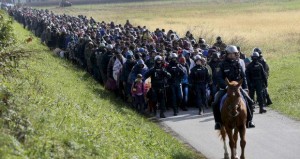 Of course, the option of illegalised travel by land routes is also treacherous: hunger, thirst, exposure, abandonment and the related lethal risks are not the exclusive travails of maritime journeys. On 27 August 2015, Austrian police discovered an abandoned meat truck on the highway at Nicklesdorf near the Hungarian border in which the bodies of 71 (mainly Syrian and Iraqi) migrants and refugees were decomposing in a sealed refrigeration compartment. Hundreds if not thousands of migrants and refugees have died of asphyxiation after extended periods of overcrowded transit by road or rail in sealed, unventilated shipping containers and other means of clandestine (illegalised) transport over land. Others have merely met their doom after dangling precariously from the bottoms of moving trains and trucks. In addition, migrants must navigate the sometimes deadly violence of European border enforcement authorities, as well as their “non-European” counterparts to whom they frequently outsource the most aggressive sorts of border policing, as well as other European police forces routinely engaged in the everyday work of superintending migrant precarity5. Indeed, another form of border casualty arises from the lack of access to critical healthcare during extended periods of migrant transit, or the callous disregard for migrant and refugee medical needs during detention or deportation. Furthermore, any consideration of the diffuse violence of these extended border zones must not neglect to consider the less systematic but no less systemic physical attacks of far right anti-immigrant racists6.
Of course, the option of illegalised travel by land routes is also treacherous: hunger, thirst, exposure, abandonment and the related lethal risks are not the exclusive travails of maritime journeys. On 27 August 2015, Austrian police discovered an abandoned meat truck on the highway at Nicklesdorf near the Hungarian border in which the bodies of 71 (mainly Syrian and Iraqi) migrants and refugees were decomposing in a sealed refrigeration compartment. Hundreds if not thousands of migrants and refugees have died of asphyxiation after extended periods of overcrowded transit by road or rail in sealed, unventilated shipping containers and other means of clandestine (illegalised) transport over land. Others have merely met their doom after dangling precariously from the bottoms of moving trains and trucks. In addition, migrants must navigate the sometimes deadly violence of European border enforcement authorities, as well as their “non-European” counterparts to whom they frequently outsource the most aggressive sorts of border policing, as well as other European police forces routinely engaged in the everyday work of superintending migrant precarity5. Indeed, another form of border casualty arises from the lack of access to critical healthcare during extended periods of migrant transit, or the callous disregard for migrant and refugee medical needs during detention or deportation. Furthermore, any consideration of the diffuse violence of these extended border zones must not neglect to consider the less systematic but no less systemic physical attacks of far right anti-immigrant racists6.
Regardless of the specific sites and forms of bordering, migrants’ and refugees’ lives have been mercilessly sacrificed — usually with callous disregard, occasionally with sanctimonious hypocrisy — in the interests of instituting a “new” Europe encircled by ever- increasingly militarised and securitised borders. Hence, following the reports of the 19 April shipwreck, as has happened repeatedly so many times before and since, European authorities were immediately catapulted into a political frenzy to redress this “tragedy of epic proportions”7. Predictably, however, despite the obligatory pronouncements of exalted humanitarian ideals, the ensuing discourse was compulsively preoccupied with “illegal” migration and the “criminal” predations of “smugglers” and “traffickers” as pretexts for renewed and expanded tactics of militarised interdiction, including proposals to bomb the coasts of Libya from which many maritime border crossers have been departing, or even to deploy ground troops.8. With a dominant discourse that strategically likened migration across the Mediterranean (now equated with “human trafficking”) to slavery9, the invocation of tragedy was cynically conscripted to supply the pretext for the fortification of various forms of border policing. This only acted to excacerbate the material and practical conditions of possibility for the escalation in migrant deaths, inevitably serving to channel illegalised human mobility into ever-more perilous pathways and modes of passage. If migrant “smuggling” is to be genuinely likened to slave trading, it is precisely the European authorities who have the power completely (and more or less immediately) to eliminate it — by reversing the very border enforcement that makes it an utter necessity. Part of the official debate turns on the question of various formulations of a kind of military humanitarianism, whereby European authorities may be charged with expanded responsibilities for the “rescue” of so-called “migrant boats” in distress on the high seas10. Nevertheless, every ostensible rescue comes to be haunted for the illegalised border crossers by the ambiguous prospect of interdiction, apprehension and indefinite detention, with deportation as a defining horizon. Indeed, the commonplace deployment of the term “asylum-seeker” inherently invokes the spectre of the allegedly “bogus” refugee seeking undue benefits or the “undeserving” migrant opportunistically claiming asylum. Indeed, people on the move across state borders are not in fact considered to be the genuine bearers of any presumptive (purportedly universal) “human right” to asylum but rather are always under suspicion of deception and subterfuge, produced as the inherently dubious claimants to various forms of institutionalised international protection. Similarly, the presumptive and pervasive depiction of refugees as (mere) “migrants” has been a crucial discursive manoeuvre in the spectacle of Europe’s border “crisis”. Little surprise, then, that begrudging gestures of belated magnanimity towards those who may ultimately be granted the status of bona fide “refugees” by European authorities have been coupled with promises of speedy expulsion for those who may eventually be deemed to be only “migrants” — illegalised, presumably undesirable and deportable.
Mass media news coverage has vacillated remarkably between depictions of a European “refugee crisis” and the label “migrant crisis” (an implicitly derisive term to the extent that it contributes to casting doubt over the validity of the refugees’ claims for asylum). Ambivalence and equivocation around the very labels by which various forms of human mobility are presumed to be knowable are telling signals of the ambiguities and contradictions that bedevil such terminological categories as governmental contrivances11. The vexed question of how most appropriately to characterise people on the move across nation-state borders is commonly deferred to an eventual decision on the part of the “proper” governmental authorities, the ostensible “experts”, who purport to manage Europe’s border regime by sorting and ranking distinct categories of mobile people — in this case, assessing asylum claims and adjudicating the matter of who may qualify as a “legitimate” and “credible” refugee. Accordingly, until such a day of reckoning, all refugees tend to be reduced to the presumed status of mere “migrants”. Again, we are reminded that the very term “asylum seeker” is predicated upon a basic suspicion of all people who petition for asylum within a European asylum system that has routinely and systematically disqualified and rejected the great majority of applicants, and thereby ratifies anew the processes by which their mobilities have been illegalised12.
The ongoing “crisis” of European borders, therefore, corresponds above all to a permanent epistemic instability within the government of transnational human mobility, which itself relies upon the exercise of a power over classifying, naming and partitioning “migrants”/ “refugees,” and the more general multiplication of subtle nuances and contradictions among the categories that regiment mobility. Indeed, such a proliferation arises as an inescapable effect of the multifarious reasons and entangled predicaments that motivate or compel people to move across state borders, or alternately find themselves stranded en route, temporarily but indefinitely stuck someplace along the way on their migratory itineraries. Refugees never cease to have aspirations. Against the dominant tendency to figure them as pure “victims” (and thus as the passive objects of others’ compassion, pity or protection), they remain subjects who make more or less calculated strategic and tactical choices about how to reconfigure their lives and advance their life projects despite the dispossession and dislocation of their refugee condition. In other words, in these fundamental ways, all refugees resemble “migrants”. And likewise, migrants are often “in flight” (or “fleeing”) from various social or political conditions that they have come to consider intolerable, thereby actively “escaping” or deserting forms of everyday deprivation, persecution or (structural) violence that may be no less pernicious for their mundanity. Hence, migration may often be a way to flee from social conditions marred by all the indignities of poverty and the routine but no less contemptible injustices of local hierarchies. Thus, many migrants also resemble “refugees”. Hence, the labels “migrant” and “refugee” commonly remain suspended in a state of tension and ambiguity, and may only be sorted into neat and clean distinctions, or separated by hermetically-sealed partitions, through more or less heavy-handed governmental interventions.
 In the face of the resultant proliferation of alternating and seemingly interchangeable discourses of “migrant” or “refugee crisis”, the primary question that must be asked, repeatedly, is: Whose crisis? Describing the situation as a “crisis” appears to be precisely a device for the authorisation of exceptional or “emergency” governmental measures aimed at enhancing and expanding border enforcement and immigration policing13. The spectacle of Europe’s “migrant crisis” is largely equated, consequently, with a crisis of control over the ostensible borders of Europe. One such European border, configured at the port of Calais in France near the entrance to the Channel Tunnel connecting Britain to the continent, has long been a site where migrants have regrouped their energies during more or less protracted periods of deceleration in the makeshift migrant and refugee camps notoriously known as “the Jungle”14. Following militant strike action by French port and ferry workers, a few thousand migrants and refugees charged the Eurotunnel barriers during the end of July 2015 in an effort to board trucks and trains heading into Britain, provoking massive traffic delays. French authorities deployed riot police and the British constructed a new razor wire fence. Confronting this “Calais crisis,” British Prime Minister David Cameron reacted with promises of deportations and alarmist calls for moreaggressive border policing to stop the migrant “swarm,” accompanied by a clamour of British tabloid newspapers calling for the authorities to “send in the army”15.
In the face of the resultant proliferation of alternating and seemingly interchangeable discourses of “migrant” or “refugee crisis”, the primary question that must be asked, repeatedly, is: Whose crisis? Describing the situation as a “crisis” appears to be precisely a device for the authorisation of exceptional or “emergency” governmental measures aimed at enhancing and expanding border enforcement and immigration policing13. The spectacle of Europe’s “migrant crisis” is largely equated, consequently, with a crisis of control over the ostensible borders of Europe. One such European border, configured at the port of Calais in France near the entrance to the Channel Tunnel connecting Britain to the continent, has long been a site where migrants have regrouped their energies during more or less protracted periods of deceleration in the makeshift migrant and refugee camps notoriously known as “the Jungle”14. Following militant strike action by French port and ferry workers, a few thousand migrants and refugees charged the Eurotunnel barriers during the end of July 2015 in an effort to board trucks and trains heading into Britain, provoking massive traffic delays. French authorities deployed riot police and the British constructed a new razor wire fence. Confronting this “Calais crisis,” British Prime Minister David Cameron reacted with promises of deportations and alarmist calls for moreaggressive border policing to stop the migrant “swarm,” accompanied by a clamour of British tabloid newspapers calling for the authorities to “send in the army”15.
Remarkably, by August, September and October 2015, literally from week to week and even day to day, the apparent “frontline” of European border struggles was repeatedly dislocated from one country to another, oftentimes further and further removed from any imagined outer periphery or frontier of “Europe”, in a dramatic dialectic of contestation between diverse migrant and refugee autonomies and a haphazard variety of tactics of bordering. These ostensible “frontline” dramas of the borders of Europe had moved decidedly inward, from the shores of Italy, Malta and Greece (or Greece and Bulgaria’s land borders with Turkey) to Macedonia, Serbia and Hungary, then further still into Austria and Germany, and then back again to Croatia and Slovenia. By November, Germany, Austria, the Czech Republic, Slovakia, the Netherlands, Belgium, France, Italy, Spain and Sweden had all begun to reintroduce temporary border controls. Pronouncements that the Schengen agreement was effectively “dead” became commonplace16.
Then, the grisly spectacle of “terrorism” in Paris on 13 November 2015 supplied the catalytic event that could conjure anew the well-worn spectre of “Muslim extremism”. Ornamented with a (fake) Syrian passport conveniently deposited in the vicinity of one of the bombings, the horrific bloodbath in the heart of genteel Europe was quickly conscripted to allege that the seemingly uncontrollable refugee influx was somehow providing cover for a nefarious ambush by the putative “enemies” of “civilisation” itself, and therefore that the “refugee” (or “migrant”) “crisis” truly represented a “security” threat, after all17. Immediately following the events in Paris, within a few hours — and within days of having been branded a “lawless slum” that presents the risk of an “infiltration” of “guerrilla warfare” — the migrant and refugee camps at Calais were subjected to a suspected arson attack18
In the ensuing days, amidst the predictable (indeed, obligatory) speculations about a hydra-headed phantasm of “foreign fighters” and “home-grown extremists” travelling unhindered between combat zones in Syria and western European countries, France — long among the most stalwart advocates of European integration — stridently called for an unprecedented securitisation of the external borders of the EU’s Schengen zone of “free” mobility. Within a week of the events, amidst police raids against Muslim “suspects” across multiple countries, and various calls for mass internment, deportations, and the electronic monitoring of such “suspects,” EU interior and justice ministers convened an “emergency” meeting and vowed to institute significantly tighter external border controls and expanded surveillance over human mobility, of citizens and non-citizens alike. The urgent push to create new “hotspot” migrant and refugee reception and processing facilities (i.e. detention camps) at sites of illegalised border crossing, likewise, came now to be re-imagined as a matter of perimeter defence against “terrorist” infiltration, with these borders re-figured as vital strategic sites for “culling terrorist wolves from refugee sheep”19.
Despite the fact that all of the alleged culprits of the Paris shootings identified were in fact (racialised “minority”) Europeans, the spectacle of terror nevertheless served quite effectively as a virtually unquestionable pretext for dramatically reinvigorated border enforcement. Soon thereafter, following the Paris events and numerous other incidents in 2015 that fashioned the figure of Europe’s “Muslim” Other in securitarian terms (as a “threat” of religious “fundamentalism,” “fanaticism” and “terrorism”), there followed the abrupt outbreak in January 2016 of a moral panic over multiple sexual assaults during the New Year’s Eve festivities in Cologne. Allegedly perpetrated by “unruly mobs” of young men, casually characterised as being “of North African or Middle Eastern appearance” (and eagerly depicted as including recently arrived “asylum-seekers”), this hysteria notably reinvigorated the racialisation of “Muslim” identity. In the face of these offences, the racialisation of “Muslims”/“Arabs” could now be represented in terms of unsavoury “cultural” differences that must be castigated and criminalised as transparently inimical to purportedly “European” values. Thus, once confronted with the palpable presence of recent arrivals of “Muslim” refugees and migrants, the apparent danger of “terrorism” was followed up with a much broader projection of gendered and sexualised menace, and “criminality” more generally. Even the tragic figure of 3 year old Aylan Kurdi — the Syrian refugee boy whose death by border shipwreck became such a a catalytic image in September — had by January (following the Cologne scandal) been viciously affiliated by the anti-Muslim racists of Charlie Hebdo with the grotesque spectre of ape-like (Muslim male) sexual predators. Whereas “anti-terrorist” suspicion follows a rather selective logic that has been mobilised for the purposes of more stringent (external) border enforcement, the propagation of the idea of allegedly “uncivilised” (“Muslim”) cultural difference has been promptly re-purposed as a considerably more expansive problem of (internal) policing. Most importantly, the specific instances of sexual harassment and sexual predation have been immediately and emphatically conjoined to arguments for new powers to hasten the deportation of any and all “criminal” asylum-seekers. Thus, refugees, formerly (if very briefly) figured as “deserving” of compassion and protection, have been very rapidly re-fashioned — first as potential “terrorists” who surreptitiously infiltrate the space of Europe, and then as potential “criminals” or rapists who corrode the social and moral fabric of “Europe” from within.
Border Struggles
Notably, brutal border spectacles of “exclusion” have often exposed their own obscene dynamics of subordinate (illegalised) migrant “inclusion”20. The various deployments of troops or riot police against migrants and refugees, the construction of razor-wire barricades and assaults against migrant and refugee families with tear gas, stun grenades and rubber truncheons, have been intermittently alternated with the outright facilitation of these same migrant movements through the provision of bus caravans and trains to expedite transit onward. Hence, state tactics of bordering have been abundantly shown to be convulsive reaction formations, responding always to the primacy of the sheer autonomy of migration21.
This was perhaps nowhere more dramatically manifest than the self-mobilisation on 4 September 2015 of refugees and migrants who had been encamped in Budapest’s Keleti railway station. Hungarian riot police had begun to deny migrants access to trains by which they aspired to travel on to Austria and Germany and had attempted to forcibly evacuate some of them. Following various skirmishes with the riot police in the makeshift refugee camp in the train station, and then a devious re-routing of trains by the authorities toward “transit” (detention) camps outside of the city, at least 1,000 migrants and refugees chanting “Freedom!” indignantly coalesced into an ad- hoc protest march (quickly designated the “March of Hope”).Following the determined leadership of a one-legged man, they proceeded onto a six-lane highway leading out of the country. This action promptly culminated in the Hungarian state authorities’ capitulation and compliance, albeit cynical and self-serving, with the urgency of the refugees’ determination to freely move forward on their chosen itineraries. The march was provided a police escort and then buses that would transport the unruly refugees and migrants further along on their journeys toward the next border. Likewise, Austria and Germany promptly confirmed that their borders were open22.
 Just the day before, Hungary’s right-wing prime minister Viktor Orbán had proclaimed that Europe’s putative magnanimity towards refugees and migrants was “madness,” and argued that his attempts to close the border with Serbia with a razor-wire fence were a matter of defending Europe’s “Christian roots” against a Muslim menace23.
Just the day before, Hungary’s right-wing prime minister Viktor Orbán had proclaimed that Europe’s putative magnanimity towards refugees and migrants was “madness,” and argued that his attempts to close the border with Serbia with a razor-wire fence were a matter of defending Europe’s “Christian roots” against a Muslim menace23.
Orbán has repeatedly declared baldly that Hungary does not welcome the prospect of granting residence to refugees, and Muslim refugees in particular. Earlier in the summer, Hungary had already announced its refusal to honour the Dublin regulation (by which other European signatory states could deport refugees to Hungary if they had first been registered as asylum claimants there). In short, much like Italy, Malta, Greece and Bulgaria previously, Hungary — now as a “frontline” defender of the borders of the EU — had come to actively resist the imperative that it do the proverbial “dirty work” of insulating the wealthiest EU member states from migrant and refugee mobilities seeking ultimately to resettle where they would have better prospects.
Such junior partners in the fragmented and externalised bordering of “Europe” — including EU member states (such as Hungary), non-EU European states (such as several Balkan countries), and “non-European” states subcontracted to pre-empt migratory movements before they ever reach European territory (from Turkey through North Africa, and even several sub- Saharan African countries) — have been poignantly depicted as “wardens of the European border regime”24 Indeed, as in the case of Hungary, the more aggressive tactics in Europe’s extended border zones have sometimes served proactively (and cynically) to re-direct human mobilities onward toward other borders within other states’ jurisdictions. Then, in September, Hungary instituted emergency legislation in the border zone that threatened all border crossers with up to three years imprisonment, in flagrant disregard for any and all petitions for asylum — in an extravagant gesture of renewed commitment to its assigned role in enforcing the borders of “Europe”. “Paradoxically,” as Bernd Kasparek and Marc Speer underscore, “Hungary is now being pilloried for its callous attempts at maintaining the rules of the European border and migration regime, while Germany, regardless of its role as architect and driving force of that very regime, wins worldwide acclaim for its humanitarian stance”25
Indeed, after having initially opened their borders to the mass movement of refugees and migrants, Austria and Germany were later prompted to re-institute their own border controls in the face of the sheer volume and velocity of human mobility through Hungary, in order to better “manage” the “crisis.” Most importantly, despite their more draconian proclivities, Hungarian authorities opted to do nothing in the face of the refugees’ defiant march through Budapest except assist them on their way toward the border with Austria. Thus, the example of Hungary is merely the most dramatic instance of a recurrent vacillation between vicious violence and begrudging complicity on the part of state powers seeking to re-institute Europe’s borders in the face of the veritable incorrigibility of migrant and refugee movements. The “crisis” of border control and “migration management” may therefore be seen to be a crisis of state sovereignty that is repeatedly instigated, first and foremost, by diverse manifestations of the autonomous subjectivity of human mobility itself.
What is fundamentally a moment of governmental impasse — in short, a “crisis” of territorially-defined state power over transnational, cross-border human mobility — has been mobilised and strategically deployed as “crisis” for the reconfiguration of tactics and techniques of border policing and immigration and asylum law enforcement. The uneven geopolitics of policing the borders of “Europe” and the heterogeneous tactics of various nation states for managing the resultant “crisis”, as we have seen, have riddled the project of European integration and border harmonisation with its own irreconcilable contradictions. Meanwhile, EU citizens have mobilised solidarity campaigns under the banner of “Refugees Welcome” and, most poignantly, organised automotive caravans to openly provide material and practical assistance to refugees in the completion of their cross-border journeys from Hungary into Austria and Germany, in flagrant defiance of legal prohibitions that would construe such acts of compassion and solidarity as the “trafficking” or “smuggling” of “illegal” migrants, and hence as criminal offences. These actions have only served to amplify and telescope the fracture between the power of European states and large numbers of their own citizens who sided with the migrants’ and refugees’ struggles26. In other words, such solidarity movements help to underscore a fracture between the presumptive sovereignty of state powers and the communities otherwise figured as the polities from which such claims to sovereign power are purported to be “democratically” derived. Thus, the larger conflictive processes of bordering “Europe” have generated a still larger political crisis for the European Union more generally. In this regard, it is the incorrigible autonomy of migration that has instigated a crisis for “Europe” as such.
A Question of “Europe”
It is not difficult to see that the strategies and tactics of bordering, even when they are anticipatory and presumably regulatory — that is, whether they are intended to preempt or, alternately, to facilitate or even proactively channel one or another formation of border crossing — are always themselves embedded within larger reaction formations. In other words, the tactics of bordering can be understood to be reactions because they are responses to the prior fact of human mobility on a global scale, and consequently take shape in reaction to all the unpredictable and incorrigible dimensions of the elementary subjectivity and autonomy of migration. The profound source of the intractable “crisis” of migration in Europe mustconsequently be seen as a veritable struggle over the borders of Europe — migrants’ and refugees’ struggles to realise their heterogeneous migratory projects by exercising their elementary freedom of movement, thereby appropriating mobility, transgressing the border regime as well as the struggle of European state powers to subdue and discipline the autonomy of migration27.
Notably, the European border “crisis” has been commonly depicted in depoliticising language as a “humanitarian” crisis with its root causes always attributed to troubles “elsewhere,” usually in desperate and chaotic places ostensibly “outside” of Europe. These putative “elsewheres,” beyond the borders of Europe, are systematically represented as historically sanitised, which is to say, shorn of their deeply European/ (post)colonial histories as well as disarticulated from the European political and economic interests implicated in producing and sustaining their fractured presents. The refugees and migrants whose mobilities may be productively understood to appropriate the space of “Europe” (cf.) nevertheless most commonly originate from places across Africa, the Middle East and Asia that were formerly the outright or de facto colonies of European masters28. In effect, migrants arriving in Europe today, much as has been true for several decades, originate from places that were effectively mass-scale prison labour camps where their forebears contributed to collectively producing the greater part of the material basis for the prosperity, power and prestige of Europe historically. Virtually all migrations and refugee movements that today seek their futures in Europe have been deeply shaped by an indisputably European (colonial) past. Furthermore, particularly for those who flee the devastation of war and military occupation or civil war — from Afghanistan or Iraq to Syria, Libya, Somalia or Mali (to name but a few) — the expansive human consequences of what Derek Gregory has incisively called the (U.S.-dominated, global) “colonial present” (cf.) are likewise inextricable from their entrenched and enduring European (“post”-colonial) entanglements29. Consequently, with the imposition, enforcement and continuous reconfiguration of a “European” border over the last decades, a brave new “Europe” has, in effect, been busily redrawing the colonial boundary between a “European” space largely reserved “for ‘Europeans’ only” and the postcolonial harvest of centuries of European exploitation and subjugation30. It is a new Europe fortified by very old and morbid cruelties.
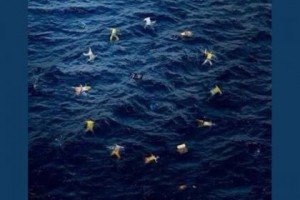 The spatialised partitioning of “Europe” from its putative “outside” notably begins within Europe itself, where the borders of “Europe” and the boundaries of “European”-ness have repeatedly been re-instituted in the uneasy borderlands that extend eastward. The legacies of the Cold War have ensured that some regions of “the East” of Europe have been, and largely remain, a crucial reserve of migrant labour, both within and across the borders of EU citizenship and mobility31. This is particularly pertinent with regard to the Balkans, as Europe extends eastward towards Turkey as perhaps the most enduring Orientalised frontier. Hence, the recent prominence of the “Balkan route” for migrant and refugee movements has been haunted by the awkward fact that several European countries themselves have yet to be admitted into the self- anointed circle of genuine and proper “European”-ness. Moreover, while there are intimations that some of these illegalised mobile subjects (Syrians in particular) may ultimately be recognised to be credible and worthy recipients of the status of “refugees,” there are concurrent and insistent assurances by various European authorities that speedy deportation will be the rightful fate for others who may be rejected as mere “migrants,” notably including those originating in the Balkan countries themselves32. The duplicitous insinuation here is that the devastating effects of the internecine violence of the Yugoslavian civil wars can now be assumed to be simply over and done with, and consequently that human mobilities from the Balkan region are purely “economic” in motivation. In addition, we must also be alert to the systematic deployment of “Balkan” and other “eastern European” regional or national-origin categorisations as evasive euphemisms for Roma (“Gypsy”) identities, in particular33. As one of the foundational and constitutive “internal” racial Others of Europe, the Roma are now reconstructed anew as a mobile (racialised, criminalised) menace to the stability and integrity of (western) European “civilisation”, whose flight from protracted poverty and entrenched marginalisation must not even conceivably be apprehensible as the mobility of “refugees” fleeing institutionalised persecution and structural violence in Europe34.
The spatialised partitioning of “Europe” from its putative “outside” notably begins within Europe itself, where the borders of “Europe” and the boundaries of “European”-ness have repeatedly been re-instituted in the uneasy borderlands that extend eastward. The legacies of the Cold War have ensured that some regions of “the East” of Europe have been, and largely remain, a crucial reserve of migrant labour, both within and across the borders of EU citizenship and mobility31. This is particularly pertinent with regard to the Balkans, as Europe extends eastward towards Turkey as perhaps the most enduring Orientalised frontier. Hence, the recent prominence of the “Balkan route” for migrant and refugee movements has been haunted by the awkward fact that several European countries themselves have yet to be admitted into the self- anointed circle of genuine and proper “European”-ness. Moreover, while there are intimations that some of these illegalised mobile subjects (Syrians in particular) may ultimately be recognised to be credible and worthy recipients of the status of “refugees,” there are concurrent and insistent assurances by various European authorities that speedy deportation will be the rightful fate for others who may be rejected as mere “migrants,” notably including those originating in the Balkan countries themselves32. The duplicitous insinuation here is that the devastating effects of the internecine violence of the Yugoslavian civil wars can now be assumed to be simply over and done with, and consequently that human mobilities from the Balkan region are purely “economic” in motivation. In addition, we must also be alert to the systematic deployment of “Balkan” and other “eastern European” regional or national-origin categorisations as evasive euphemisms for Roma (“Gypsy”) identities, in particular33. As one of the foundational and constitutive “internal” racial Others of Europe, the Roma are now reconstructed anew as a mobile (racialised, criminalised) menace to the stability and integrity of (western) European “civilisation”, whose flight from protracted poverty and entrenched marginalisation must not even conceivably be apprehensible as the mobility of “refugees” fleeing institutionalised persecution and structural violence in Europe34.
Consequently, the “crisis” of European borders is eminently political, in manifold ways. Most importantly, these struggles expose the fact that the borders of “Europe” are never reducible to anything resembling immutable, integral, internally consistent or objective boundaries corresponding to any self-evident “natural” fact of physical geography. Nor can these European borders be apprehensible as simply the outward projections of a stable and coherent centre, whereby the socio-political, “cultural” or “civilisational” identity and spatial integrity of “Europe” may be presupposed in contradistinction with a variety of othernesses “beyond” or “outside” the ostensible limits demarcated by those boundaries. Instead, Europe’s borders, like all borders, are the materialisations of socio-political relations that mediate the continuous production of the distinction between the putative “inside” and “outside,” and likewise mediate the diverse mobilities that are orchestrated and regimented through the production of that spatial divide. Thus, with respect to the abundant inequalities of human mobility, the borders of “Europe” are simultaneously entangled with a global (postcolonial) politics of race that re-draws the proverbial colour line and re-fortifies “European”-ness as a racial formation of whiteness, and a comparably global (neoliberal) politics of transnational labour mobility and capitalist labour subordination that produces such spatialised (and racialised) differences, above all, to capitalise upon them35.
To the extent that the European Union entails a transnational and partially supranational juridical and political formation, however, with an extraordinarily variegated and graduated spectrum of differential (and never perfectly harmonised) arrangements that regulate and modulate its “internal” and “external” relations, a high degree of instability and mobility is inherent in the very existence of the externalised and virtualised borders that may now be characterised as “European.” Thus, “Europe” presents to us today a transnational and intercontinental laboratory for the neoliberal regimentation and subordination of human powers and freedoms in relation to the space of the planet.
For many illegalised “asylum seekers,” braving the horrors of the European border regime comes only after fleeing from all manner of atrocities, persecution and misery in their countries of origin and, commonly, also in numerous other countries of “transit,” crossed en route to Europe, which have been materially and practically incorporated to various extents into the externalised policing of the frontiers of “Europe”. For most of these same refugees as well as many others who migrate in the quest to make a better life for themselves and their loved ones, the vicious severities of this extended and expansive European border-zone present a fierce endurance test, a preliminary apprenticeship in what promises to be a more or less protracted career of migrant “illegality,” precarious labour and deportability36. However, whether these mobile subjects come to be governed as “refugees” or “migrants”, their needs, desires, and aspirations always supersede this death-defying obstacle course — albeit, at times, at the cost of their lives. Little surprise, then, that one mode of critical response to the European border regime’s ultimate responsibility for the April shipwreck was to invoke an analogy with the premier slogan of contemporary African American civil rights struggles in the United States — Black Lives Matter — by insisting that Migrant Lives Matter. Here, we are reminded that in the European context, the very figure of migration is racialised, even as dominant discourses of migration in Europe systematically disavow and dissimulate race as such37. Haunted as Europe’s borders are by this appalling proliferation of (almost exclusively non-European/ non- white) migrant and refugee deaths and other forms of structural violence and generalised suffering, anyone interested in the politics of class and race today cannot avoid confronting the urgent and anxious question of the borders of Europe, and therefore must inevitably come to recognise that the question of Europe itself has become inextricable from the question of migration38.
A genuinely critical examination of borders and migration in Europe unsettles and destabilises “Europe” as taken for granted assumption, and instigates a confrontation with the problem of “Europe” itself39. Much as the borders of Europe have been instituted and are constantly being policed for the sake of stabilising and purportedly “protecting” the space of “Europe” — first and foremost, and above all, as a preserve for the presumable birthright entitlements of “Europeans” — the unrelenting struggle over the autonomous mobility of “non- Europeans” across those symbolic and material boundaries continuously instigates a re-staging of the borders of “Europe” as sites of their own subversion, and concomitantly, as the scene for the spectral un-doing of “Europe” itself. The borders of Europe therefore present a premier site for the enactment and disputation of the very question of and about “Europe”: the question of “Europe” itself has become inextricable from the question of migration.
Theorising the Migrant-Refugee-Border “Crisis”
In the foregoing, I have already begun to introduce a series of crucial concepts that can serve the task of sustaining a viable critique. Now, I would like to approach our subject anew through a series of more directly, explicitly and emphatically theoretical gestures.
Borders are not inert, fixed or coherent “things.” Rather, as in Marx’s analysis of capital, borders are better seen as socio-political relations. What is at stake in these relations, which are indeed relations of struggle, is the rendering of borders into seemingly fixed and stable thing-like realities with a semblance of objectivity, durability and intrinsic power. Thus, the agonistic coherence and ostensible fixity of borders — their thing-like qualities — only emerge as the effect of active processes by which borders must be made to appear thing-like. In other words, they must be continuously objectified through repetitive practices and discourses. This very process of transposing what is in fact always an unresolved social relation into the semblance of a durable objective reality, however, implies that the objectification of borders is inherently fraught and antagonistic. The struggles at and around borders are struggles over the open-ended process of continuously objectifying borders (the process of making borders into objects, or objective facts), and thereby lending them the fetishised quality of unquestionable realities with a power unto themselves.
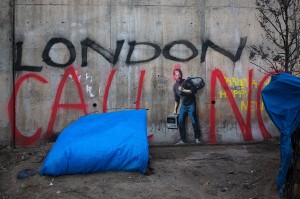 The objectification and fetishisation of borders, therefore, may be best apprehended if we appreciate that bordering is indeed a verb, and signals a process of border-making. Simply put, bordering — border-making activity — involves productive activity, work, a kind of labour. The very acts and processes that produce borders, however, are the very same socio-political activity that subsequently comes to look like some sort of natural and inevitable result of borders as such. In other words, rather than see borders as the cumulative effect of the diverse acts of bordering (such as passport checks, policing, fences, etc.) — instead of seeing “the border” as the product of all this work, in other words — we are induced to see all these heterogeneous human activities as merely subsidiary or derivative features that emanate from the apparently already-existing reality and objectivity of borders as such.
The objectification and fetishisation of borders, therefore, may be best apprehended if we appreciate that bordering is indeed a verb, and signals a process of border-making. Simply put, bordering — border-making activity — involves productive activity, work, a kind of labour. The very acts and processes that produce borders, however, are the very same socio-political activity that subsequently comes to look like some sort of natural and inevitable result of borders as such. In other words, rather than see borders as the cumulative effect of the diverse acts of bordering (such as passport checks, policing, fences, etc.) — instead of seeing “the border” as the product of all this work, in other words — we are induced to see all these heterogeneous human activities as merely subsidiary or derivative features that emanate from the apparently already-existing reality and objectivity of borders as such.
Once objectified thus, we may nevertheless recognise borders to be enduringly productive. Borders, in this sense, may be considered to be a kind of means of production — for the production of space, or indeed, the production of difference in space40. As enactments in and upon space, like any means of production, borders must themselves be produced and continuously re-produced. Yet, as a means of production, borders are generative of larger spaces, differentiated through the relations that they organise and regiment, facilitate or obstruct.
Customarily, we have perhaps been inclined to conceive of these spatial differences as the differentiation of nation-state spaces, but as the convulsive supra-national space of the EU or the historical spaces of empire readily confirm, territorially-defined spaces of state formation have always been historically specific, contingent and heterogeneous. Nonetheless, the differences that borders appear to naturalise — between “us” and “them,” between “here” and “there” — are in fact generated precisely by the real incapacity of borders to sustain and enforce any rigid and reliable separations.
Borders today seem to have become inextricable from migration, and are made to paradoxically appear to be both “the problem” and “the solution”. Borders, then, are notably perceived to be always-already violated, and thus perpetually inadequate or dysfunctional, if not frankly corrupted. And this is true in spite of ever-increasing border securitisation; indeed, the securitisation of borders only intensifies the perception that they are in fact always insecure, supplying the premier site for staging the perpetual demand for more securitisation41. No number of borderzone arrests or deportations could ever be sufficient to sustain the semblance of “security” but rather only the seeming verification of a thankless and relentless task, a job that can never be completed.
Here, as I have already argued, human mobility always comes first. Muchas the subjective (creative, productive) force of labour necessarily always precedes its objectification as capital, the primacy of the autonomy and subjectivity of human freedom of movement is a recalcitrant and obstreperous force that precedes and exceeds any border authority’s capacities for comprehensive regimentation and control. Once bordered, which is to say, once subjected to one or another tactic of bordering, the autonomy and subjectivity of the varieties of human mobility that are thereby construed as border-crossing come to be known as “migration”. Thus, the autonomy and subjectivity of human mobility always instigates the reaction formations of bordering that convert particular forms of human mobility into the bordered social formations that we come to know (only retrospectively) as “migration”. Hence, if there were no borders, there would be no migrants — only mobility. As we have seen repeatedly with the recent translation of the putative “crisis” of the European asylum and migration regime into a veritable re-bordering of the EU’s Schengen zone of “free mobility” through the re-instituting of border checkpoints in the name of enhancing “control,” the ubiquity of migrant mobilities comes first; the ubiquity of borders and the diverse panoply of new techniques and technologies of border policing and immigration enforcement come always as a response on the part of the state. Indeed, migration regimes signify precisely the politicisation of the elemental human freedom of movement by subjecting human mobilities to state power.
These processes of subordinating human mobilities to the sovereign power of states and border regimes are fundamentally implicated in the larger production of spatialised difference that I have identified with borders. That is to say, the bordering of mobilities is also a process for the production of difference, and its effects are differentially distributed. Therefore, although borders are ideologically constructed and celebrated as if their real purpose were simply “exclusion” — functioning as a barrier that “protects” what is inside by shutting out what is outside — they operate in fact in ways that are much more equivocal, as amorphous zones that can be permeated and transgressed, and thus, as sites of encounter and exchange. In spite of the semblance of inadequacy or dysfunction, whereby borders appear to be wracked by “crises” because they are so persistently violated or transgressed, borders nonetheless serve quite effectively and predictably as filters for the unequal exchange of various forms of value42The filtering character of borders is especially visible in those instances where the intensified enforcement of border crossings of easiest passage relegates illegalised migrant mobilities into zones of more severe hardship and potentially lethal passage, as we have seen with the conversion of the Mediterranean into a space of mass death. In a de facto process of artificial selection, these deadly obstacle courses serve to sort out the most able-bodied, disproportionately favouring the younger, stronger and healthier among prospective (labour) migrants, and disproportionately favouring men over women. The militarisation and ostensible fortification of borders, furthermore, prove to be much more reliable for enacting a strategy of capture than as mere technologies of exclusion. Once migrants have successfully navigated their ways across such borders, the onerous risks and costs of departing and later attempting to cross yet again become inordinately prohibitive.
The more extravagant border policing becomes, the more in fact it participates in what I have called the Border Spectacle – persistently and repetitively implicating the materiality of border enforcement practices in the symbolic and ideological production of a brightly lit scene of “exclusion” that is always in reality inseparable from an obscene fact of subordinate (illegalised) inclusion that transpires in its shadows43. Thus, in our efforts as radical activists to denounce the extremities and severities of plainly cruel modes of exclusion, we risk forfeiting the critical responsibility to also detect how regulatory regimes produce regularities44 Indeed, we risk failing to see that migrant “irregularity” (“illegality”) is itself a very regular and predictable feature of the routine and systematic functioning of border and immigration enforcement regimes, and thus, we risk an unwitting complicity with the supreme monologue of the Border Spectacle itself, by recapitulating its dominant theme of “exclusion”. Hence, rather than adopting political positions that treat borders as purely exclusionary and consequently promoting such slogans as “Open the borders!” in the (liberal) spirit of advocating greater “inclusion”, what we really need to advance instead is the abolition of all borders as an elementary and defining feature of the capitalist state. Through borders, states legally and politically produce and mediate the social and spatial differences that capital may then capitalize upon and exploit.
Much of my previous work has similarly been dedicated to problematising any simplistic binary of “inclusion” and “exclusion,” in part through the elaboration of the concepts of “inclusion through illegalisation”45 and “inclusion through exclusion”46. Here, it is important to underscore that the illegalisation or irregularisation of migrants — precisely, as labour — is always a kind of subordinate incorporation. This sort of inclusion may be best depicted as obscene precisely because it is not merely concealed, but also selectively revealed. What constitutes the obscene is not that it remains hidden but rather that it gets exposed. Thus, the spectacle of border policing stages the regulatory regime of immigration enforcement as always besieged by the inexorable “invasion” or “inundation” of “illegal” migrants, and in this manner routinely serves to verify precisely the regularity of “irregular” migrants’ obscene inclusion and the sheer banality of their despised presence within the space of the state.47.
If borders are productive of differences in material and practical ways, then it is crucial to note that they not only involve a physics (through the mobilisation of various practices and material technologies of bordering) but also sustain a definite metaphysics. The metaphysics of borders is centrally implicated in the particularisation of the political (as a feature of the global relation of labour and capital). Politics is thus made particular according to distinct histories of struggle in specific places. But the generalised dominant form for this global political relation involves a universalisation and normalisation of the “national” state form. The “national” (territorially defined and delimited) form of the state has therefore become the standard framework of “politics” in a nationalist world order. Simply put, borders constantly reinforce the ideological image of a world composed of “nations” and “national” states, to which all territory — and importantly, all people — must consistently and exclusively correspond. This metaphysics of borders plays a role on an effectively global scale. Indeed, we may be reminded here of Hannah Arendt’s memorable depiction (following the Second World War) of “the new global political situation” as “a completely organised humanity” resembling a “barbed-wire labyrinth”48. Borders, as we have come to know them, do not only distinguish the official outer limits of state territory and institute the division between one space of sovereign power and another, but also subdivide the planet as a whole. In so doing, borders also subdivide humanity as a whole49. Consequently, in a world where the workers truly have no country, they are nonetheless made to appear to be first and foremost the “nationals” (or “citizens”) of one or another state.
Borders cross everyone, including those who never cross borders. As socialists, then, we must confront this fundamental problem: Will we finally become the (witting or unwitting) accomplices of border policing, even if only by adopting uncritically the nationalist standpoint of the state that presumes to act as the sovereign power behind any given border regime? Or alternately, as genuine internationalists, will we align ourselves conscientiously on the side of our own elementary freedom of movement and reject all (nation-)state borders, and struggle deliberately for the fundamental reconfiguration of the relation between the human species and the space of the planet?
References
Agier, Michel, 2011, Managing the Undesirables: Refugee Camps and Humanitarian Government (Polity).
Andersson, Ruben, 2014 Illegality, Inc.: Clandestine Migration and the Business of Bordering
Europe. (University of California).
Arendt, Hannah, 1968 (1951), The Origins of Totalitarianism. (Harvest/Harcourt).
Ataç, Ilker, Stefanie Kron, Sarah Schilliger, Helge Schwiertz, and Maurice Stierl,
2015, “Struggles of Migration as In-/Visible Politics.” Movements: Journal für kritische
Migrations- und Grenzregimeforschung http://movements- journal.org/issues/02.kaempfe/01.ataç,kron,schilliger,schwiertz,stierl–einleitung~en.html Balibar, Étienne, 1991a, “Es Gibt Keinen Staat in Europa: Racism and Politics in Europe Today.” New Left Review, I/186.
Balibar, Étienne, 1991b, “Is There a ‘Neo-Racism’?” in Étienne Balibar and Immanuel
Wallerstein. Race, Nation, Class: Ambiguous Identities (Verso).
Balibar, Étienne, 1991c, “Racism and Crisis.” in Étienne Balibar and Immanuel Wallerstein.
Race, Nation, Class: Ambiguous Identities (Verso).
Balibar, Étienne, 1992 (2002), “Is There Such a Thing as European Racism?” in Balibar (2002),
Politics and the Other Scene (Verso).
Balibar, Étienne, 2002 (1993), “The Borders of Europe”, in Balibar (2002), Politics and the
Other Scene (Verso).
Balibar, Étienne, 2004a (1999), “At the Borders of Europe”, in Balibar, We, the People of
Europe? Reflections on Transnational Citizenship (Princeton University Press)
Balibar, Étienne, 2004b (1999), “Droit de Cité or Apartheid?” in Balibar, We, the People of
Europe? Reflections on Transnational Citizenship. (Princeton University Press).
Balibar, Étienne, 2009, “Europe as Borderland”, Environment and Planning D: Society and
Space 27(2).
Bialasiewicz, Luiza, 2012 “Off-shoring and Out-sourcing the Borders of EUrope: Libya and EU Border Work in the Mediterranean”, Geopolitics 17(4).
Bojadžijev, Manuela, and Serhat Karakayali, 2010 “Recuperating the Sideshows of Capitalism: The Autonomy of Migration Today”, e-flux #17.
Casas-Cortes, Maribel, Sebastián Cobarrubias, and John Pickles, 2011 “Stretching Borders Beyond
Sovereign Territories? Mapping EU and Spain’s Border Externalisation Policies.” Geopolitica(s)
2(1).
De Genova, Nicholas, 2002 “Migrant ‘Illegality’ and Deportability in Everyday Life.” Annual
Review of Anthropology 3.
De Genova, Nicholas, 2005, Working the Boundaries: Race, Space, and “Illegality” in Mexican
Chicago (Duke).
De Genova, Nicholas, 2007, “The Production of Culprits: From Deportability to Detainability in the Aftermath of ‘Homeland Security’”, Citizenship Studies 11(5).
De Genova, Nicholas, 2010a, “Antiterrorism, Race, and the New Frontier: American
Exceptionalism, Imperial Multiculturalism, and the Global Security State.” Identities, 17(6).
De Genova, Nicholas, 2010b, “The Deportation Regime: Sovereignty, Space, and the Freedom of Movemen: Theoretical Overview”) in Nicholas De Genova and Nathalie Peutz, eds. The Deportation Regime: Sovereignty, Space, and the Freedom of Movement (Duke University Press).
De Genova, Nicholas, 2010c, “Migration and Race in Europe: The Trans-Atlantic Metastases of a Post-Colonial Cancer”, European Journal of Social Theory 13(3).
De Genova, Nicholas, 2010d, “The Queer Politics of Migration: Reflections on ‘Illegality’ and
Incorrigibility.” Studies in Social Justice 4(2):.
De Genova, Nicholas, 2011 “Spectacle of Security, Spectacle of Terror”, in Shelley Feldman, Charles Geisler, and Gayatri Menon (eds.), Accumulating Insecurity: Violence and Dispossession in the Making of Everyday Life (University of Georgia Press).
De Genova, Nicholas, 2013, “Spectacles of Migrant ‘Illegality’: The Scene of Exclusion, the
Obscene of Inclusion”, Ethnic and Racial Studies 36(7).
De Genova, Nicholas, 2015a, “Extremities and Regularities: Regulatory Regimes and the
Spectacle of Immigration Enforcement”, in Yolande Jansen, Robin Celikates, and Joost de Bloois (eds.), The Irregularisation of Migration in Contemporary Europe: Detention, Deportation, Drowning (Rowman & Littlefield).
De Genova, Nicholas, 2015b, “In the Land of the Setting Sun: Reflections on ‘Islamisation’ and
‘Patriotic Europeanism’”, Movements: Journal für kritische Migrations- und
Grenzregimeforschung 1(2), http://movements-journal.org/issues/02.kaempfe/15.de-genova–
pegida-islamisation-patriotic-europeanism.html>.
De Genova, Nicholas, 2016a, “The ‘European’ Question: Migration, Race, and Post-Coloniality
in ‘Europe’”, in Anna Amelina, Kenneth Horvath and Bruno Meeus, eds., An Anthology of Migration and Social Transformation: European Perspectives (IMISCOE Research Series/ Springer).
De Genova, Nicholas, 2016b , “The Whiteness of Innocence: Charlie Hebdo and the Metaphysics of Antiterrorism in Europe.”, forthcoming in Gavan Titley, Des Freedman, Gholam Khiabany and Aurélien Mondon, eds., Suis-je Charlie? Politics and Media after the Paris Attacks (Zed Books).
De Genova, Nicholas and Martina Tazzioli, 2015, “The ‘European’ Question after Charlie
Hebdo: An Interview with Nicholas De Genova by Martina Tazzioli.” Darkmatter, Number 12;
<http://www.darkmatter101.org/site/category/issues/12-border-struggles/>
De Genova, Nicholas and Martina Tazzioli, eds, 2016 “Europe/ Crisis: New Keywords of ‘the
Crisis’ in and of ‘Europe’”,. Near Futures Online (Zone Books).
Doppler, Lisa, 2015, “‘A Feeling of Doing the Right Thing’: Forming a Successful Alliance against Dublin-Deportations.” Movements: Journal für kritische Migrations- und Grenzregimeforschung, 1(2);Available at: <http://movements- journal.org/issues/02.kaempfe/12.doppler–successful-alliance-against-dublin-deportations.html> Dzenovska, Dace, 2013 “The Great Departure: Rethinking National(ist) Common Sense”, Journal of Ethnic and Migration Studies 39(2).
Fekete, Liz, 2014, “Europe against the Roma”, Race & Class 55(3).
Fox, Jon E, 2012 , “The Uses of Racism: Whitewashing New Europeans in the UK”, Ethnic and
Racial Studies 36(11).
Garelli, Glenda and Martina Tazzioli, 2013, “Arab Springs Making Space: Territoriality and Moral
Geographies for Asylum Seekers in Italy.” Environment and Planning D: Society and Space
31(6).
Garelli, Glenda and Martina Tazzioli, 2016, “The EU Humanitarian War against Migrant
Smugglers at Sea.” Antipode (forthcoming)
Garelli Glenda, Federica Sossi, and Martina Tazzioli, eds, 2013 Spaces in Migration: Postcards of a
Revolution (Pavement Books).
Goldberg, David Theo, 2006 “Racial Europeanisation.” Ethnic and Racial Studies 29(2).
Gregory, Derek, 2004 The Colonial Present (Blackwell).Grill, Jan, 2012, “‘It’s Building up to Something and It Won’t Be Nice When it Erupts’: Making of Roma Migrants in a ‘Multicultural’ Scottish Neighborhood”, Focaal 62: 42-54.
Hepworth, Katherine, 2012, “Abject Citizens: Italian ‘Nomad Emergencies’ and the Deportability of Romanian Roma,” Citizenship Studies 16 (3-4).
Hepworth, Katherine, 2015, At the Edges of Citizenship: Security and the Constitution of Non-citizen Subjects (Ashgate).
Karakayali, Serhat and Enrica Rigo, 2010 “Mapping the European Space of Circulation.” in Nicholas De Genova and Nathalie Peutz, eds. The Deportation Regime: Sovereignty, Space, and the Freedom of Movement (Duke).
Kasparek, Bernd and Marc Speer, 2015 “Of Hope: Hungary and the Long Summer of Migration.”
bordermonitoring.eu (9 September), http://bordermonitoring.eu/ungarn/2015/09/of-hope-en/ Kearney, Michael,2004 “The Classifying and Value-Filtering Missions of Borders”
,Anthropological Theory 4(2).
Lefebvre, Henri, 1991(1974), The Production of Space (Blackwell).
Mezzadra, Sandro, 2006, “Citizen and Subject: A Postcolonial Constitution for the European
Union?” Situations 1(2).
Mezzadra, Sandro, 2011, “The Gaze of Autonomy: Capitalism, Migration, and Social
Struggles”, in Vicki Squire, ed. The Contested Politics of Mobility: Borderzones and Irregularity
(Routledge).
Mezzadra, Sandro, and Brett Neilson, 2013, Border as Method, or, the Multiplication of Labour
(Duke).
Millner, Naomi, 2011 “From ‘Refugee’ to ‘Migrant’ in Calais Solidarity Activism: Re-Staging
Undocumented Migration for a Future Politics of Asylum” Political Geography 30. Mitropoulos, Angela, 2006 “Autonomy, Recognition, Movement”, The Commoner 11. Moulier Boutang, Yann,
1998 De l’esclavage au salariat. Economie historique du salariat bridé (Presses Universitaires
de France).
Moulier-Boutang, Yann, and Stany Grelet, 2001, “The Art of Flight: An Interview with Yann
Moulier-Boutang.” Rethinking Marxism 13(3/4).
Papadopoulos, Dimitris, Niamh Stephenson, and Vassilis Tsianos, 2008, Escape Routes:
Control and Subversion in the 21st Century (Pluto).
Reinisch, Jessica, 2015, “‘Forever Temporary’: Migrants in Calais, Then and Now,” Political
Quarterly (18 September 2015).
Rigby, Joe, and Raphael Schlembach, 2013, “Impossible Protest: Noborders in Calais.” Citizenship
Studies 17(2).
Stierl, Maurice, 2015, “The WatchTheMed Alarm Phone: A Disobedient Border-Intervention”,
Movements: Journal für kritische Migrations- und Grenzregimeforschung, 1(2), http://movements-journal.org/issues/02.kaempfe/13.stierl–watchthemed-alarmphone.html. Tazzioli, Martina, 2013, “Migration (in) Crisis and ‘People Who Are Not of Our Concern’”, in Glenda Garelli, Federica Sossi, and Martina Tazzioli (eds). Spaces in Migration: Postcards of a Revolution (Pavement Books).
Tazzioli, Martina, 2014, Spaces of Governmentality: Autonomous Migration and the Arab
Uprisings (Rowman and Littlefield).
Tazzioli, Martina, 2015a, “The Desultory Politics of Mobility and the Humanitarian-Military
Border in the Mediterranean: Mare Nostrum Beyond the Sea”, REMHU: Revista Interdisciplinar da Mobilidade Humana 23(44), http://www.scielo.br/scielo.php?pid=S1980-
85852015000100061&script=sci_arttext&tlng=es
Tazzioli, Martina, 2015b, “Which Europe? Migrants’ Uneven Geographies and Counter- Mapping at the Limits of Representation.” Movements: Journal für kritische Migrations- und Grenzregimeforschung, 1(2), http://movements-journal.org/issues/02.kaempfe/04.tazzioli– europe-migrants-geographies-counter-mapping-representation.html
Tsianos, Vassilis, and Serhat Karakayali, 2010 “Transnational Migration and the Emergence of the European Border Regime: An Ethnographic Analysis.” European Journal of Social Theory 13(3).
van Baar, Huub, 2011, “Europe’s Romaphobia: Problematisation, Securitisation, Nomadisation.”
Environment and Planning D: Society and Space 29(2).
van Houtum, Henk, 2010, “Human Blacklisting: The Global Apartheid of the EU’s External Border
Regime”, Environment and Planning D: Society and Space 28(6).
van Houtum, Henk and Roos Pijpers, 2007, “The European Union as a Gated Community: The Two- faced Border and Immigration Regime of the EU”, Antipode 39(2).
Walters, William, 2009 “Europe’s Borders”, in Chris Rumford, ed, Sage Handbook of European
Studies (Sage).
Walters, William, 2011, “Foucault and Frontiers: Notes on the Birth of the Humanitarian
Border,” in Ulrich Bröckling, Susanne Krasmann, and Thomas Lemke, eds, Governmentality: Current Issues and Future Challenges (Routledge).
* It will appear in April in the journal International Socialism Number 150 (2016)
Acknowledgments: This article has benefitted from the critical comments and thoughtful suggestions of Ruben Andersson, Glenda Garelli, Fiorenza Picozza, Maurice Stierl, and Martina Tazzioli, who each responded to an earlier draft. In addition, this text has been inspired by dialogue and debate within the research network on “The ‘European’ Question:: Postcolonial Perspectives on Migration, Nation, and Race.” I am also grateful to all those who shared their insights and criticisms during various public presentations, particularly Alex Callinicos, Charles Heller, Sandi Hilal, Stathis Kouvelakis, Simon Parker, Alessandro Petti, Lucia Pradella, and Eyal Weizman. ↩
De Genova and Tazzioli, 2016 ↩
De Genova, 2013 ↩
The most comprehensive database documenting migrant and refugee deaths during attempts to traverse the borders of Europe is “The Migrants’ Files” <www.themigrantsfiles.com>, a data project coordinated by Journalism++, which estimates the total number of European border deaths at more than 30,000. ↩
Andersson, 2014 ↩
Ataç et al, 2015; De Genova, 2015b. ↩
Garelli and Tazzioli, 2016, and <http://www.theguardian.com/world/2015/may/13/migrant-crisis-eu-plan-to-strike- libya-networks-could-include-ground-forces>. ↩
For various contributions to the critique of the discourse of slavery,” see <https://www.opendemocracy.net/beyondslavery>. ↩
Garelli and Tazzioli, 2016; Tazzioli, 2014; 2015a; se also Agier, 2011; Walters, 2011. ↩
Garelli and Tazzioli, 2013; Tazzioli, 2013 and 2014 ↩
De Genova, 2013 and 2016a ↩
13 De Genova and Tazzioli, 2016. ↩
Millner, 2011; Reinisch, 2015; Rigby and Schlembach, 2013; Tazzioli, 2015b. ↩
<http://www.theguardian.com/uk-news/2015/jul/30/david-cameron-migrant-swarm-language-condemned> ↩
The Schengen agreement had established a European area free of border controls or passport checks for citizens from the 26 signatory countries. The Schengen accord pre-dated the European Union, but was incorporated into the EU’s Amsterdam Treaty of 1997, with provisions for some member states to opt-out. The Schengen Area includes 22 of the 28 EU member states, plus an additional 4 countries that are not EU members. ↩
For more general discussions of the metaphysics of anti-terrorism and the rise of specifically anti-Muslim racism in the context of the production of discourses of a “Muslim menace”, see De Genova, 2007, 2010a,c, 2011, and 2015b; for a discussion of the Charlie Hebdo shootings in Paris in January 2015, see De Genova, 2016b, and De Genova and Tazzioli, 2015. ↩
<http://www.express.co.uk/news/world/619361/Calais-Jungle-migrant-camp-fire-Paris-terror-
attacks?utm_content=buffer4b0c3&utm_medium=social&utm_source=twitter.com&utm_campaign=buffer>. ↩
http://www.nytimes.com/2015/11/26/world/europe/regulating-flow-of-refugees-gains-urgency-in-greece-and- rest-of-europe.html?mc=edit_th_20151126&nl=todaysheadlines&nlid=44765954 ↩
De Genova, 2013. ↩
For contributions to the elaboration of the critical concept of the “autonomy of migration,” see Mezzadra, 2011; Mezzadra and Neilson, 2013; Moulier Boutang, 1998; Moulier-Boutang and Grelet, 2001. See also Bojadžijev and Karakayali, 2010; De Genova, 2009 and 2010d; Karakayali and Rigo, 2010; Mitropoulos, 2006; Papadopoulos, Stephenson, and Tsianos ,2008; Tsianos and Karakayali, 2010. ↩
<http://www.nytimes.com/interactive/projects/cp/reporters-notebook/migrants/syrian-migrants-in-austria>. See also Kasparek and Speer, 2015. ↩
<http://www.theguardian.com/world/2015/sep/03/migration-crisis-hungary-pm-victor-orban-europe-response-madness>. ↩
Ataç et al. 2015. On the wider topic of the externalisation of the borders of the EU, see Andersson, 2014; Bialasiewicz, 2012; Casas-Cortes, Cobarrubias, and Pickles, 2011; Tsianos and Karakayali, 2010; Walters, 2009. ↩
Kasparek and Speer, 2015. Subsequently, it was indeed Germany’s Chancellor Angela Merkel who re-initiated negotiations between the EU and Turkey that sought to reward Turkey with at least €3 billion in exchange for an expanded role in policing the external borders of the EU and the more effective containment of more than 2 million Syrians and other refugees and migrants. As Merkel put it, such measures would help to “keep people in the region,” which is to say, keep them out of Europe. In addition, the EU re-opened stalled negotiations regarding an extension of visa-free travel privileges to (qualifying) Turkish citizens, as well as the larger question of Turkey’s prospective admission to EU membership. <http://www.nytimes.com/2015/11/30/world/europe/eu-offers-turkey-3- billion-euros-to-stem-migrant-flow.html?emc=edit_th_20151130&nl=todaysheadlines&nlid=44765954&_r=0> ↩
Ataç et al, 2015; Doppler, 2015; Kasparek and Speer. 2015; Stierl, 2015. ↩
See Ataç et al, 2015; Garelli and Tazzioli, 2013; Karakayali and Rigo, 2010; Kasparek and Speer, 2015; Tazzioli, 2015b. ↩
De Genova, 2016a; Garelli and Tazzioli, 2013; Garelli, Sossi, and Tazzioli, 2013; Mezzadra, 2006; Tazzioli, 2015b ↩
Gregory, 2004. See De Genova, 2010a. ↩
De Genova, 2010c, and 2016a; see also van Houtum, 2010; and van Houtum and Pijpers, 2007 ↩
Dzenovska, 2013. ↩
Indeed, on November 18, 2015, EU-member states Slovenia and Croatia, followed by non-EU countries Serbia and Macedonia, abruptly closed their borders to any would-be “asylum-seekers” who could not provide identity documents confirming that they came from Syria, Iraq or Afghanistan — effectively segregating refugees according to national origin; <http://www.nytimes.com/aponline/2015/11/19/world/europe/ap-eu-europe-migrants.html>. ↩
Fox, 2012; Grill, 2012; Hepworth, 2012. ↩
Fekete, 2014; Hepworth, 2015; van Baar, 2011. ↩
De Genova, 2016a; De Genova and Tazzioli, 2015. ↩
De Genova, 2015a; see also De Genova, 2002 and 2010b. ↩
Balibar, 1991a,b,c, 1992, and1999b; De Genova, 2010c; 2016a, b; Goldberg, 2006. ↩
Ataç et al, 2015; Balibar, 1991a,b,c, 1993,1999a, and 2004; De Genova, 2016a; Karakayali and Rigo, 2010; Mezzadra, 2006; Tazzioli, 2015b; Walters, 2009. ↩
De Genova, 2016a. ↩
See, generally, Lefebvre, 1991. ↩
De Genova, 2011 ↩
Kearney, 2004. ↩
De Genova, 2013; see also De Genova, 2002, and 2005, pp. 242-49. ↩
De Genova, 2015a. ↩
De Genova, 2002, p439, and 2005, p. 234. ↩
De Genova 2010b,c. ↩
De Genova, 2013. ↩
Arendt, 1968, pp. 297, 292. ↩
De Genova, 2010b. ↩




